

Tao Te Ching
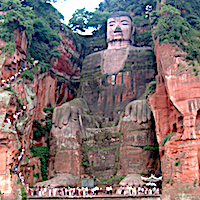
233' tall Leshan Buddha
Tang Dynasty 唐朝 (618 – 907 CE)
During the "Dark Ages" in Europe, the re-invigorated Tartar-Han biological mix, the new spiritual inspiration from Buddhism, and the influence from one of China's best emperors, Taizong; brought about the Tang Dynasty, a cosmopolitan gold age and high point of Chinese culture. The population grew to over 80 million, the capital in Xian became the largest city in the world, and it's influence spread to Korea, Vietnam, Japan and all of East Asia. During this time, China silk sold for its weight in gold in Europe while Chinese wealth increase beyond anything previously known. Poets and painters were promoted to high office, "whoever was a man was a poet," and an anthology of Tang poems made during the Qing Dynasty include 48,900 poems made by 2,300 poets. Arthur Waley described it as "the most polished epoch that the world had ever seen" and Murdoch as "the most powerful, the most enlightened, the most progressive, and the best-governed empire on the face of the globe." Innovations during this time included woodblock printing hundreds of years before Gutenberg, the first dated and printed book (The Diamond Sutra), the world's first mechanical clocks, water and fireproofing chemicals, dental fillings, the identification of diabetes and its treatment, the first gas cylinders, a rotary fan for air conditioning, the invention of porcelain, grafting, gunpowder, handcarts, harmonicas, parachutes, playing cards, toothbrushes, and paper money.
Sages (83)
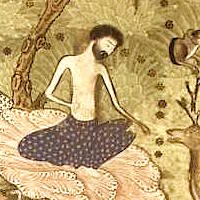
Abu Yazid al-Bisṭāmī بایزید بسطامی
804 – 874 CE
Famous Sufi, ”King of the Gnostics,” forefather of ecstatic Islamic mysticism; Abu Yazid disavowed excessive asceticism and changed the course of Sufism by shifting the emphasis from discipline, obedience and piety to direct experience and “self-annihilation in the Divine Presence.” An active shrine to him in Bangladesh was built and has been used since 850 CE and he remains an important lineage holder in thelargest Sufi brotherhood, the Naqshbandi.
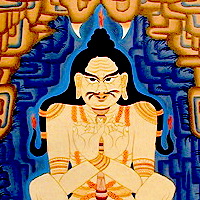
Aciṅta ཨ་ཙིངྟ་།། ("The Avaricious Hermit")
862 – 912 CE
Mahasiddha #38
Acinta ཨ་ཙིངྟ་། Achingta, “The Greedy Hermit” (second half of 9th century)
Born into extreme poverty, constantly and completely fixated on becoming wealthy; Acinta couldn’t forget his intense desire for riches. Tormented by his greed and unable to escape from it, he met a teacher who gave him a Jambhala wealth practice and initiation into the irresistibleness of a thought-stopping empty mind free from gaining ideas. His dreams of wealth dissolved into a realization of nothing to gain, he became known as “The Thought-Free Guru,” served countless beings, and initiated many disciples into this ultimate reality. Mahasiddha #38
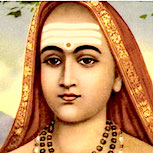
Adi Shankara
788 – 820 CE
Philosopher, theologian, and sage; Shankara unified and established the main philosophical trends in Hinduism. He criticized the dogmatic and ritually oriented schools, emphasized that enlightenment can be realized in this lifetime, and established monastic, personal-practice and direct-experience traditions. Writer of fundamental texts of the Vedanta school and responsible for a major Hindu revival, he is called the source of all the main currents of modern Indian thought. His teachings are similar to Mahayana Buddhism and he was called a "crypto-Buddhist" but he explained the difference being the Buddhism teaching of no self and his that the whole universe is the self - which may be a way of saying the same thing.
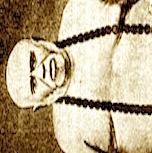
Ajogi ཨ་ཛོ་གི་པ། ("The Rejected Wastrel")
9th Century CE
Mahasiddha #26
As a child in a rich family, Ajogi was so fat that his parents had to do everything for him. He wouldn’t even get up to go to the bathroom or eat. When this became too much for his parents they first threatened and then actually abandoned him to cremation grounds in the midst of half-burned bodies and wild animals. Still not willing to get off his back, a wandering wise guru challenged his helplessness strategy - not by trying to make him change but by accepting Ajogi’s situation exactly as it was and working with it. This story and practice gives inspiration and a practical path for the most freakish, despised, and rejected. Mahasiddha #26
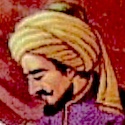
Al-Kindi (Abu Yūsuf Yaʻqūb ibn ʼIsḥāq aṣ-Ṣabbāḥ)
801 – 873 CE
While European countries were still stuck in the dark ages of almost universal superstition and ignorance, Al-Kindi - knows as “father of Arabic philosophy” - precipitated the “Moslem Enlightenment,” one of the true golden ages of human history, a time that threw off its dogmatic shackles of uncritical belief and advanced science, direct experience unfettered by external sources, understanding of the sense and not just the words. A famous historian, physician, polymath, musician and mathematician; he brought Hellenistic wisdom into the Muslim world and shocked his contemporaries by appreciating Christianity.
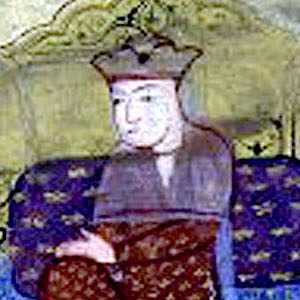
Alan Gua (Алун гуа)
832 – 884 CE
"Alun the Beautiful"
Living ten generations before Genghis Khan, Alan Gua is credited with forging the original Mongol clans together when she taught her five sons the parable of the five arrows showing them how easy it is to break one arrow but how impossible when the five are bound together. This image was powerful enough to overcome her first two son’s suspicions and jealousy when she had three more sons after their father died and explained the new births as a result of a heavenly, “glittering visitor” who came through her yurt’s roof on moonbeams “like a yellow dog.” This story/image transmitted from the Mongols to the Iroquois Confederacy through Deganawida and Hiawatha and to the US Founding Fathers becoming incorporated as the Great Seal of the United States and the same essential message into the US Constitution.
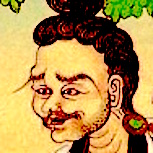
Bhadrapa
8th century CE
A “goody-two-shoes,” Brahmin purist intent on complete political correctness and purity; when the cleanliness obsessed and wealthy Bhadrapa met a homeless yogin he was repelled and cried out, “Unclean!” The teacher countered that physical form isn’t unclean, only the psychological corruption of body, speech, and mind. Bhadrapa realized his bigotry, that real purity means giving up ego-clinging and has nothing to do with following conventions and religious rules. He became a disciple, renounced his caste privileges and practices, cleaned latrines as his spiritual practice and became a great Mahasiddha himself.

Bhadrapa
8th C. CE
A “goody-two-shoes,” Brahmin purist intent on complete political correctness and purity; when the cleanliness obsessed and wealthy Bhadrapa met a homeless yogin he was repelled and cried out, “Unclean!” The teacher countered that physical form isn’t unclean, only the psychological corruption of body, speech, and mind. Bhadrapa realized his bigotry, that real purity means giving up ego-clinging and has nothing to do with following conventions and religious rules. He became a disciple, renounced his caste privileges and practices, cleaned latrines as his spiritual practice and became a great Mahasiddha himself.
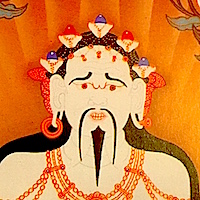
Campaka ཙ་མྤ་ཀ (“The Flower King”)
820 CE –
Mahasiddha #60
Extremely wealthy, powerful, caught up in pleasure, and sitting on a throne made from sweet-smelling flowers; Kampala met a wandering yogi. He tried to impress the sage with the splendors of his kingdom and the beauty of his flowers but the sage told him the truth, that his flowers smelled great but his body not so much, that his realm was wonderful but before long it and he would be gone. Realizing the superficiality and meaninglessness of his life, Kampala began a spiritual path but only shifted his physical materialism into spiritual materialism. Directed to focus his meditation on “the flower of pure reality,” he practiced and finally realized the empty essence of his mind. Mahasiddha #60
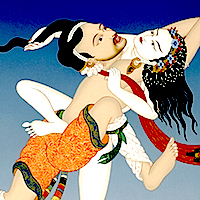
Carbaripa ཙ་རྦ་རི་པ། (Carpati, “The Petrifier”)
9th Century CE
Mahasiddha #64
Legends about Carbaripa seem to fit better in the shaman lineage than the buddhist one. These stories could be an example of reinterpretating symbols from a different point of view. From the shamanistic point of view, stories about him turning people to stone imply magic and the power of place. From the buddhist viewpoint, these can be interpreted as a teacher’s ability to disperse disciples discursive thoughts and distractibility, their skill in inspiring the transformative powers of deep meditation. A deeper meaning can be understood in how he liberated people from their petrified social and cultural concepts. The main legend about him describes him helping a young wife abused and beaten by her wealthy husband and his aggressive, controlling mother. The stories don’t describe but pictures of him frequently show him copulating in the sky with this young wife. Mahasiddha #64
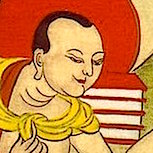
Catrapa ཙ་ཏྲ་པ། ("The Lucky Beggar")
750 – 850 CE
Mahasiddha #23
Catrapa while begging always carried a small dictionary that attracted a wise teacher who asked him about the book and then his life. This led to teachings and a practice of dissolving all concepts, prejudice, negative and moral conditioning, and a blending of action with perception into a deep, non-dual awareness of each everyday experience in life. Instead of teaching morals, ethics, and discipline; he exemplified and taught the crazy wisdom of wu wei, enlightened spontaneity based on direct, unfiltered realization. Mahasiddha #2
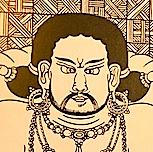
Cauraṅgipa ཙཽ་རངྒི་པ། ("The Dismembered Stepson")
10th century CE
Mahasiddha #10
Saintly son of a king, Cauraṅgipa’s arms and legs were cut off when he refused the amorous advances of his step-mother who lied and slandered him. The servants offered to take the body parts from their own children but he refused, not wanting to cause harm to others. Left to die under a tree, he met his guru Minapa who gave him meditation practices that saved his life and led to his complete realization, “the one taste of all things.” His physical loss of limbs became a foundation and benefit to his practice. (graphic credit: Robert Beer) #10

Chamaripa ཙཱ་མཱ་རི་པ། (Cāmāripa, “The Siddha Cobbler”)
840 – 940 CE
Mahasiddha #14
A poor cobbler in ancient India, Chamaripa worked long hours making and repairing shoes while he dreamed of a higher, more meaningful life. Disgusted with the emptiness of his life he begged teaching from a wandering teacher and began a practice of visualizing his work as meditation practice, his tools and materials as symbols for deep understandings. He discovered how the thread that tied his shoes together was like the thread of emptiness (shunyata) that connects a core enlightenment back through our graspings for fame, fortune, pleasure, and power. Mahasiddha #14

Chéng Xuanying 成玄英 (Ch'eng Hsuan-ying)
631 – 655 CE
A Daoist monk and exceptional scholar during the early Tang dynasty, Xuanying wrote highly respected commentaries and summaries on both Lao Tzu and Chang Tzu. The first emperor of Tang invited him to the capital and gave him the title, “Master of West China” but he was later exiled. He taught that “mystery” means profundity, that it persists neither in Being nor in Nonbeing, that we should not persist in “mystery,” but negate it. This led to Zhuangzi's thought and the Buddhist philosophy of the Middle Way. His tradition was called the “Twofold Mystery School” and his writings on this made it the main influence on Daoist philosophy of the time.
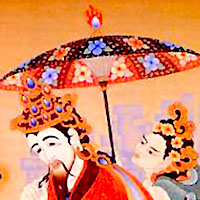
Dārikapa དཱ་རི་ཀ་པ། (“Slave-King of the Temple Whore”)
8th century CE
Mahasiddha #77
In a somewhat typical story, this wealthy and powerful king enjoying all the pleasures of his privilege meets an enlightened master, realizes the emptiness of his life, and gives away everything to follow his guru. In this case though, he also gives away his body and freedom which his teacher sells to a famous prostitute, Darima. After many years of serving as her slave and practicing his dharma; Darima, her many attendants, guards, slaves, and customers became disciples who he taught and served for many years. Mahasiddha #77
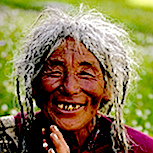
Ḍeṅgipa ཌེངྒི་པ། (“The Courtesan's Brahmin Slave”)
9th Century CE
Mahasiddha #31
Brahmin minister to a king who left his wealth and status for a spiritual path, Ḍeṅgipa met his guru but because he had no appropriate gift to give offered his body as a slave. His guru then - to reduce his royal pride, racial discrimination, and to give him a practice - sold him as a slave to a prostitute. After 12 years of service mainly threshing rice, he discovered the one taste of all things, merged space and awareness, and became spiritual teacher to the prostitute as well as to the hundreds of people in that district. Mahasiddha #31
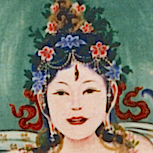
Dharima
10th century CE
Prostitute, consort of the famous Mahasiddha Tilopa, slave owner and student of Mahasiddha Luipa (probably a different person with same name and profession); Dharima and Tilopa started on this spiritual path together, practiced together for many years, and when enlightened taught together. They learned the "Illusory-body" yoga from Nagarjuna’s tradition, Dream yoga from Caryapa, Cakrasamvara and the Clear Light from Lavapa, and from the woman saint Subhagini, Candalini-yoga and the Hevajra tantra. They forged these 4 traditions into what became the Kagyu lineage of Mahamudra that continues powerfully today through teachers like Chogyam Trungpa and the Karmapas.
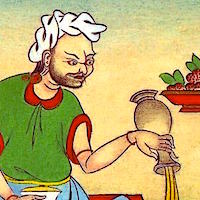
Dhilipa དྷི་ལི་པ། (“The Epicurean Merchant”)
10th century CE
Mahasiddha #62
Dhilipa had a sesame oil pressing business that did really well and made huge profits. He devoted this wealth to personal pleasure-seeking and is said to have had at each meal 84 main courses, 12 deserts, and 5 kinds of beverages prepared by the best chefs of the time. After one of these sumptuous banquets, a dharma teacher guest questioned him about how far his pleasure seeking was really taking him and pointed out that he could go on making more and more money but it wouldn’t bring him any more true happiness or realization. Like he extracted oil from sesame seeds, Dhilipa then extracted dualistic concepts from experience, realized the union of opposites, and burned the pure flame of awareness. Mahasiddha #62
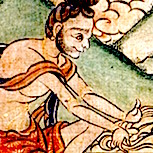
Dhobīpa དྷོ་བཱི་པ། (“The Wise Washerman” )
806 – 906 CE
Mahasiddha #28
From a family of washermen in a country where purification and cleanliness were high spiritual values and people were expected to take ritual baths twice a day, Dhobipa spent his time washing clothes and cleaning things. A wandering, wise yogi visited him with a piece of coal and asked him to clean it, to take out the stain. Recognizing that the impossibility of cleaning coal by washing is like the impossibility of realizing wisdom with dogmatic belief, increasing goodness with materialistic intentions, or healing inner wounds with mindless ritual; Dhobipa went beyond convention and became a great teacher himself. Mahasiddha #28
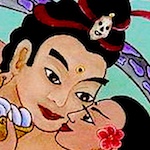
Dombipa
10th C. CE
Enlightened ruler of Magadha (Kashmir), Dombipa treated all his subjects like a “father would treat his only child” but his country suffered almost endless war, crime, famine, and poverty. He brought back prosperity, peace, and health but when he took a low caste “untouchable” as consort and started drinking large amounts of alcohol, the shocked people forced his abdication. After 12 years when the country’s problems returned, they begged him to return which he did “riding on a pregnant tiger” with his consort. To rule them again, he asked that they abandon the caste system. When they refused he went back into his meditation saying, “My only kingdom is the kingdom of truth.” This lineage continues with the Trungpa Tulkus.

Dongshan Liangjie 洞山良价 (Dòngshān Liángjiè; Tōzan Ryōkai)
807 – 869 CE
Famous poet, Shaolin Monastery Chan monk, founder of the Caodon school which became the Sōtō Zen lineage when taken to Japan in the 13th century by Dōgen; Dongshan helped develop the koan tradition. Drawing from the I Ching, inspired by the Sandokai, and inspiring the Oxherding Pictures, his famous poem Five Ranks described the path and unification of absolute and relative realities, the highest spiritual realization in the middle of everyday life.
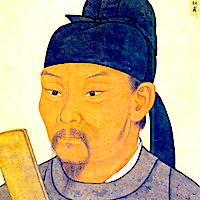
Du Fu 杜甫 杜甫
712 – 770 CE
Though Li Bai in the West is most often considered China's greatest poet, in the East, that honor most often falls to Du Fu, "the Chinese Shakespeare." Historian, sage, and compared to Milton, Burns, and Wordsworth; Du Fu failed the Chinese examinations for public office although the subject was poetry but became one of China's most influential writers. A close friend and traveling companion of Li Bai during a time of intense political change, his fortunes rose and fell from the highest honors to the depths of misery finally to be robbed of the straw in his bed while he was too weak to resist. In Japan considered the "Saint of Poetry" and the major influence on the greatest haiku poet, Matsuo Bashō; Du Fu excelled at reconciling opposites, considered "everything in this world is poetry," and became one of the greatest writers in any language.
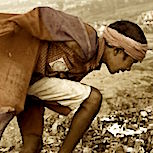
Dukhandhi དུ་ཁངྡྷི་པ། ("The Scavenger")
798 – 898 CE
Mahasiddha #25
A low caste sweeper surviving by scavengering thrown-away pieces of cloth and making them into clothes, Dukhandhi - whose name means “he who unites duality” - thought he was prevented from good meditation practice by his need to survive by constantly sewing. His teacher pointed out how he could actualize the meaning of his name by uniting his necessary life experience with his spiritual path, that they are no different. After many years of stitching together spiritual practice with his daily life experience, he became enlightened and a great teacher. Mahasiddha #25
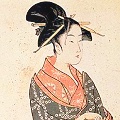
Empress Suiko 推古天皇 (Suiko-tennō)
554 – 628 CE
Emperor’s daughter, Buddhist nun, first and only confirmed Japanese Empress Regnant of Japan; Suiko’s many achievements include adopting a more useful calendar cycle, the 17-article constitution (written by Shotoku), and the official recognition of Buddhism by the issuance of the Flourishing Three Treasures Edict in 594. She was one of the first Buddhist monarchs in Japan, sponsored Buddhist temples and monasteries, and firmly established Buddhism in Japan. She orchestrated China’s first diplomatic recognition of Japan and close cultural contact with both China and Korea.
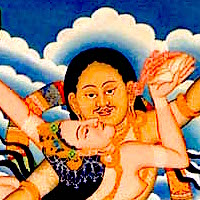
Ghaṇṭāpa གྷ་ཎྚཱ་པ། (“The Celibate Bell-Ringer”)
early 9th century
Mahasiddha #52
One of the earliest Kalacakra practitioners, founder of the Pancakrama Samvara lineage, Nalanda scholar, and guru to a king; Ghantapa became a symbol for appropriate action outside the confines of rigid ethics and morality, allegiance to personal insight over status quo strictures, and belief in the sense above the words. As a celibate monk, he saw through the chains of public and monastic opinion, desire for fame and acceptance, dissolved his vows, drank liquor, had sex, took on a consort, and had a child. His example inspired the people of his village and hearers of his stories during the centuries to dissolve their self-righteousness, prejudice, and sectarianism. Mahasiddha #52

Godhuripa གོ་དྷུ་རི་པ། (“The Bird-Catcher”)
700 – 800 CE
Mahasiddha #55
Godhuripa’s livelihood was based on killing birds. He knew this was not good and created bad karma for himself; but, he didn’t think he had a choice because this was all he knew how to do. A teacher challenged this opinion pointing out that selling his soul for material gain only made things worse in the long run. He gave Godhuripa a spiritual practice of listening to the birdsong not to find and kill the birds but to discover “the sound of silence,” the one taste and unity of sound and emptiness. He let all the birds go, gained direct perception of sound, and became a teacher with hundreds of students. Mahasiddha #55
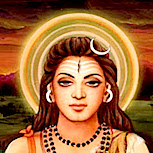
Goraksa ཤྲཱི་གོ་རཀྵ་ནཱཐ྄། (Nāth Siddha Gorakṣa, "The Immortal Cowherd")
10th Century CE
First haha yoga teacher, founder of India’s largest yoga sect, and non-sectarian Tantric leader; Goraksa assimilated Buddhist insight and understanding into a Hindu context free of duality and integrated tantric practices into Buddhist philosophy. His life symbolizes and his teachings reinforce that every condition and situation people find themselves in has equal potential for realizing the highest awareness. He emphasized the potential in even the most negative circumstances and taught to appreciate everything rather than fighting against our experience and trying to attain a fantasy of what we might think is better.

Han Shan (Cold Mountain)
c. 730-850 CE
Claimed by Buddhists as a Buddhist, by Taoists as a Taoist; Han Shan poked fun at both and living beyond any narrow categories like these, through his poems communicated a universal wisdom and truth. Not attached or attracted to honor and gain, he laughed at offered high positions and wealth. The favorite poet of everyone from Wang Anshi (1021-1086), one of China’s most famous prime ministers to Jack Kerouac who in 1958 dedicated his book Dharma Bums to him, Han Shan’s poems express complete spontaneity, total indifference to praise and blame, and continual realization of pure consciousness in the simple, ordinary details of life.

Hilda of Whitby
614 – 680 CE
Living in a brutal time of violent warlords and kings, Hilda’s mother was a poor, homeless widow. From this humble and challenging beginning, she became a powerful advisor to officials, bishops, and kings. The historian Bede wrote, “All who knew her called her mother because of her outstanding devotion and grace.” Abbess and founder of several monasteries, five men who lived and studied at one of these became bishops and two of them are now revered as saints. She is considered a patron saint of poetry, learning and culture.
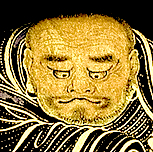
Huangbo Xiyun 黄檗希运 (Huangbo Xiyun, Huángbò Xīyùn, Obaku)
? - 850 CE
An uncompromising and fierce teacher, Huángbò often hit and shouted at his students including a future emperor of China. Though according to the Blue Cliff Record he was seven feet tall, very little is known about his personal life — unsurprising given his uncompromising disregard for conceptual thinking, his focus on egolessness and One Mind. Once when he told his students that in all of China there are no teachers of Zen, a student asked him how he could say that since he was teaching them. Huángbò answered, “I didn’t say there was no Zen, just no teachers.”

Huating Decheng 華亭德誠
820 – 858 CE
After intense study with Chan Master Yaoshan Weiyan, Decheng moved to Hua Ting and lived on a small boat. He semi-anonymously stayed in the background and passed as a very ordinary person. As an occupation, he took people across a river while—with discrete subtlety—teaching them his Chan Buddhist understanding. In a famous story, he triggered a student's enlightenment by pushing him off the boat into the river. After the students realization, Dechenbg told him not to think about him anymore and fell off the boat into the water liberating the student from the golden chains of hero-worshipping delusion.
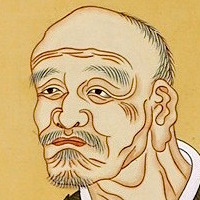
Hui Hai 大珠慧海
788 – 831 CE
Hui Hai 大珠慧海 Baizhang Huaihai (788 - 831)
Tang dynasty Chinese Chan monk, and author of the still-influential book, Essential Gate for Entry Into Sudden Enlightenment; Hui Hai became known as the “Great Pearl” because his teacher Ma-tsu Tao-i was so impressed when he read this book he praised it as “a great pearl, perfect and bright illumination that penetrates everywhere without impediment. Teacher to the famous Huangbo Xiyun, he established a set of rules for Chan monasteries still used today as well as architectural and lifestyle forms. Some of these included farming and self-sufficiency skills that enabled the Zen monasteries to survive during times of persecution and the influential saying, "A day without work is a day without food" (一日不做一日不食 "One day not work, one day not eat"). Ta-chu Hui-hai

Huineng 惠能 (Huìnéng, Enō)
638 – 713 CE
The Sutra of Hui Neng
Traditionally seen as the Sixth and Last Patriarch of Chán Buddhism, Huineng symbolizes the essence of Zen and the non-thought lineage. From a poor family, Huineng’s father died when he was young and he never learned to read and write. While working as a laborer, he heard the Diamond Sutra and immediately set off to study with the Fifth Patriarch. Since illiterate, he could only work at the monastery doing chores like chopping wood and pounding rice. Because of his deep understanding and realization though, he because the dharma heir. Like the famous story about not mistaking a pointing finger for the moon, he deeply understood the sense, not only the words.
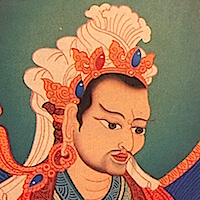
Indrabhūti ཨིནྡྲ་བྷཱུ་ཏི། ("The Enlightened Siddha-King")
892 CE –
Mahasiddha #42
Indrabhuti ཨིནྡྲ་བྷཱུ་ཏི། The Enlightened Siddha-King (late 9th century)
“The first tantrika,” archetypal tantric king, and inspiration for several tantric lineages; Indrabhuti for political reasons pledged his Buddhist sister Laksminkara in marriage to the prince of a neighboring Hindu kingdom. She went to live with the neighboring prince but soon became disillusioned with the materialism, superstition, and decadence of her new country. Late one night she fled the palace and found a cave in the mountains where she lived and practiced meditation, attained enlightenment and scandalously started teaching untouchables. This greatly upset the Hindu king but inspired Indrabhuti to do the same and leave the comfort of palace life to devote himself completely to his spiritual path. He rejected however a path that rejected sensual pleasure and sex and practiced the Guhyasamaja father-tantra in the Anuyoga Dzogchen lineage. Mahasiddha #42
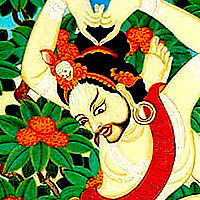
Jālandhara ཛཱ་ལནྡྷ་ར་པ། ("The Ḍākinī's Chosen One")
888 CE –
Mahasiddha #46
Jalandhara ཛཱ་ལནྡྷ་ར་པ། “The Ḍākinī's Chosen One” (late 9th century)
Another wealthy and privileged brahmin who saw through the materialistic values of his culture and renounced it to search for a more meaningful life, Jalandhara left everything to live in a cremation ground meditating. Going on to become an important mother-tantra siddha, one of the nine naths, and guru to 10 of the 84 Mahasiddhas; he founded one of the two main nath lineages (A Hindu tradition favored by Kabir that blended Shaivism, Buddhism and Yoga traditions using Hatha Yoga to transform the physical into awakened perception of “absolute reality”), taught practices that unify the male and female forces, dissolve the subject/object dichotomy, and open the non-dual doors of perception. Mahasiddha #46

Joshu, Zhàozhōu Cōngshěn 趙州從諗
778 – 897 CE
Joshu, Zhàozhōu Cōngshěn 趙州從諗 (778–897)
Called the greatest Chan master of the Tang dynasty,” Joshu traveled extensively his entire life not slowing down or teaching until he was 80 years old and then for 40 more years. Famous for his incomprehensible behavior and paradoxical teachings, many famous koans come from his realization including many in the Blue Cliff Record and one of the most well known ones that begins The Gateless Gate. His main temple was destroyed during the Cultural Revolution but later rebuilt and now a large center for modern Chinese Buddhism.

Kambala ཀམྦ་ལ་པ། ("The Black-Blanket-Clad Yogin")
9th Century CE
Mahasiddha #30
Closely connected with the feminine archetype of emptiness without ego and original authority on the mantrayana tantras, Kambala began his spiritual path as a king, left it and became a monk. He then left the relative luxury of the monastery to become a wandering yogi. Challenged by his teacher to leave even the comforts of that life, he left behind everything but a black blanket that was also taken away from him and eaten by evil feminine forces. After his turning them away from their evil ways, they gave the blanket back in small pieces that he sewed back together becoming known as “The Black-Blanket-Clad Yogin. Mahasiddha #30
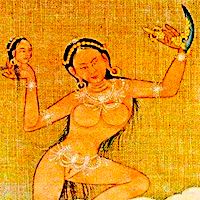
Kanakhala ཀ་ན་ཁ་ལཱ། ("The Younger Severed-Headed Sister”)
late 9th century
Mahasiddha #67
One of two unmarried, mischievous daughters; Kanakhala’s father married her off to an unsuspecting boy from another village. He soon realized though and an intense and constant “battle of the sexes” began. As their lives sunk into more and more misery, she suggested running away to another country. Mekhala, however, realized that their problems were self-created and would follow them wherever they travelled. This realization somehow seems to have triggered an encounter with a famous guru who initiated them onto a spiritual path. After 12 years, they returned to the guru but brought no offerings. According to the story, the guru asked for their heads and they immediately cut them off with “the keen-edged sword of pure awareness.”

Kanhapa ནག་པོ་པ། ("The Dark-Skinned One")
9th Century CE
Mahasiddha #17
A founder of the Nath lineages, guru to many famous gurus, great poet and singer but proud, easy-to-anger, aggressive and arrogant; Kanhapa’s story doesn’t easily fit into a list of enlightened teachers. He successively achieved levels of realization but didn’t listen to his spiritual guides, disobeyed his guru, got proud, and then suffered a downfalls. This continued until he aggressively stole some fruit, got into a fight with the dakini who owned it, and then was killed by her in retaliation. In the Crazy Wisdom, Sacred Clown, Trickster tradition; Kanhapa shows by bad example how not to behave, demonstrates deflating the ego of spiritual materialism, and shocks students out of their complacency.
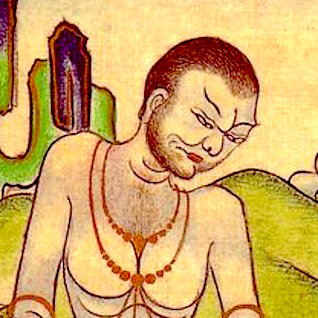
Kaṅkāripa ཀངྐཱ་རི་པ། (”The Lovelorn Widower”)
8th C. CE
Mahasiddha #7
A low caste householder happily married and filled with sensual pleasure, Kankaripa collapsed into despair when his beloved wife unexpectedly died. Confronted and asked by a wise teacher why he was letting himself grieve so much and wouldn’t let go of the corpse when “All life ends in death, every meeting ends in a parting;” he learned meditation practice, how to visualize his dead wife as a Dakini, attained ultimate realization, and became a wise, enlightened sage. Understanding how big as well as small “disasters” can become the most important, beneficial, life-changing events in our lives; this ordinary, uneducated man exemplifies transforming another affliction into spiritual path.
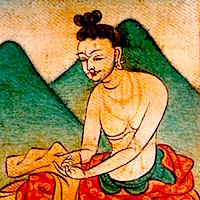
Kantalipa ཀནྟ་ལི་པ། ("The Ragman-Tailor")
800 – 900 CE
Mahasiddha #69
Living life on the deep, dark bottom of society as an untouchable and barely surviving with never a full stomach by digging rags out of garbage and sewing the small pieces into cloth; Kantalipa represents how to deal with misery, poverty, and society’s revulsion—not an easy challenge. When he accidentally stabbed himself with a needle and the blood ruined a piece of cloth he had been working on for a long time, Kantalipa hit bottom rolling around on the ground, tearing his hair, and moaning like an animal. “When the student is ready, the teacher arrives” and Kantalipa was ready. He began an intense meditation practice experiencing his needle as mindfulness, the tread as compassion, and the rags as empty space. Mahasiddha #69
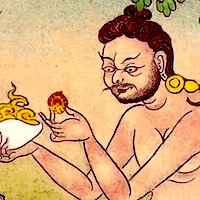
Kapālapa ཀ་པཱ་ལ་པ། (“The Skull Bearer”)
9th Century CE
Mahasiddha #72
Suicidal and lost in despair after his wife and 5 children died from a plague, Kapalapa met in a cremation grounds Kanhapa who suggested he practice the dharma rather than just die. Making a bowl from his wife’s skull and ornaments from his children’s bones, Kanhapa taught him to see the emptiness of the bones as a creative, fulfillment meditation. After years of practicing in this way, Kapalapa became a great teacher himself helping hundreds of disciples. Mahasiddha #72
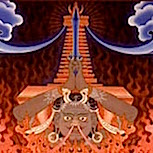
Khaḍgapa ཁཌྒ་པ། ("The Fearless Thief")
10th century CE
Mahasiddha #15
Hiding in a cremation ground after a failed robbery, Khadgapa met Carpati, an enlightened yogi and asked for some meditation practices that would make him into an invincible, uncatchable thief. Carpati gave him practices and instructions for finding the “radiant sword of undying awareness.” Khadgapa thought this sword would cut his physical enemies but instead it cut through his real foes: anger, hatred, aversion, desire, greed, sloth and stupidity. In spite of his life of crime, Khadgapa became a great Mahasiddha himself proving that any lifestyle and profession can launch the highest realizations. #15
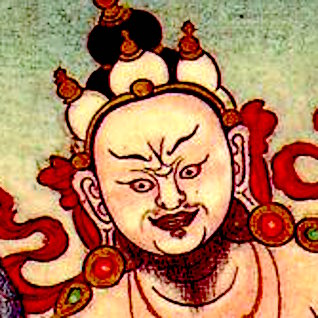
Kirapālapa ཀི་ར་པཱ་ལ་པ། (Kirapalapa, "The Repentant Conqueror")
8th century CE
Mahasiddha #73
A retelling of Ashoka’s story set in more recent times, Kilapa was a rich, powerful, and insatiable king obsessed with continually getting more wealth, power, and territory. When he personally confronts the horrors of war he completely changes and dedicates his life and kingdom to helping others, peace, education and poverty alleviation. His spiritual practice is distracted by the affairs of state until his guru gives him a visualization practice seeing his subjects as sacred beings and his kingdom as “the infinite emptiness of mind.” He then becomes a great siddha himself.
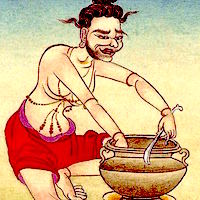
Kumbharipa ཀུམྦྷ་རི་པ། (“The Eternal Potter”)
10th century CE
Mahasiddha #63
Kumbharipa was a potter bored into despair by the repetition and meaningless tedium of his profession of making pottery. Deeply depressed and on the verge of suicide, he met a teacher who pointed out the universal nature of his unhappiness and suffering. Pointing out the symbolic understanding of the pottery wheel being like the wheel of life, our passions and thoughts being like the clay, and 6 pots being like the 6 realms; Kumbharipa practiced this insight and became enlightened entering a Lao Tzu type wu wei state with the “potter’s wheel spinning by itself and pots spring from is a joy sprang from this potter’s heart.” Mahasiddha #63
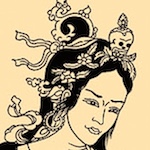
Lakshmincara ལཀྵྨཱིངྐ་རཱ།། (“The Princess of Crazy wisdom”)
c. 8th Century CE
Born into a royal family and pledged as a wife to the king of Ceylon, when Lakshmincara saw the king for the first time hunting and killing animals, she gave away her large dowry to the common people, pretended madness to stop the wedding, and moved to the charnal grounds to practice and realize enlightenment. She survived on food thrown out for dogs and took an untouchable latrine cleaner as attendant and first student. She became famous with many disciples. Her former fiancé’s father, the king Jalendra also wanted to become a disciple but she instead referred him to her student, the latrine sweeper who became his teacher. Mahasiddha #82
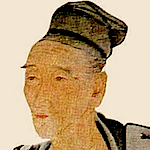
Layman Pang 龐居士
740 – 808 CE
Layman Pang 龐居士 Páng Jūshì, Hōkoji (740–808)
Successful merchant, family man, celebrated lay Buddhist; like Vimalakīrti and Marpa the translator, Pang exemplifies possibilities of the highest realization and enlightenment for people in everyday walks of life without needing to live in a monastery or remote cave, without being a yogi, monk, or nun. He did however worry about his success and wealth becoming an impediment to his spiritual path and at one point loaded all his riches in a boat that he sunk in a river. He and his family then traveled around China visiting great teachers and surviving by making and selling bamboo utensils. These travels and his words were immortalized in Blue Cliff Record koans as was his daughter Ling Zhao’s words, "Neither difficult nor easy, on the hundred grass tips, the great Masters' meaning" and "Not difficult, not easy—eating when hungry, sleeping when tired."

Li Bai 李白 (Li Bo)
701 – 762 CE
The greatest Chinese poet so widely respected that a crater on the planet Mercury was named after him, that he would appear as a character in books written by Hermann Hesse, John Steinbeck, Guy Gabriel Kay, Simon Elegant, Ursula Le Guin, and Philip K. Dick.. Immensely influential during his own time as well as subsequent generations in China, his influence extends to American Imagist and Modernist poetry through poets like Ezra Pound, Charles Bukowski, and Derek Walcott. Mastering Confucius at 10, he began writing poetry still famous today. At 12 he went to live in the mountains studying and writing, returned and wandered, married but but didn't make enough money so his wife left with their children. He became a favorite of the emperor, was rejected, wandered again, was imprisoned, sentenced to death, released to wander again, and legended to drunkenly die in a river while trying to embrace the moon's reflection.
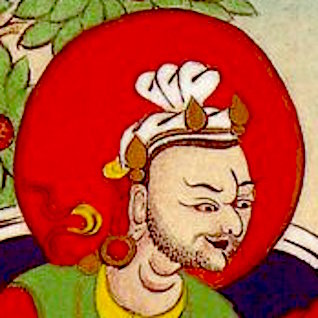
Lilapa སྒེག་པ། (“Master of Play”)
8th century CE
Mahasiddha #2
“He Who Loved the Dance of Life,” Lilapa was a king who wanted to become enlightened but didn’t want to leave the luxury and privilege of his kingdom. A wandering yogin gave him practices he could do surrounded by his riches, power, musicians, and wives. He devotedly practiced, attained realization, and became famous for his philanthropy and kind goodness. Like Epicurus in the West, Lilapa taught and exemplified how spiritual realization doesn’t depend on asceticism, rigid discipline, and self-denial but harmonizes more with appreciation, cheerfulness and respect.
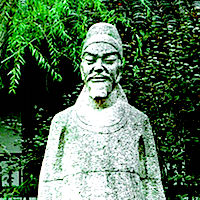
Liú Yǔxī 刘禹锡
772 – 842 CE
"Mad old man poet," politician, and philosopher
Poet, philosopher, writer; Liu Yuxi grew up in the political chaos of the time and transitioned from tutor to an heir apparent, secretary to a military governor, a high political post of Investigating Censor, to friend of many literary giants of the Tang Dynasty. He was banished, recalled, banished again because of a satirical poem, then made a provincial governor, and later governor of Suzhou. Along with famous poet/governor Bai Juyi he was known as one of the “two mad old men.” His poetry became some of the most famous throughout China, the other East Asian countries, and now—through insightful translations like Red Pine’s—in the West as well.

Lü Dongbin 呂洞賓 (Lü Tung-Pin)
796 CE -
Scholar and poet, de facto leader of the 8 Immortals, founder of the School of the Golden Elixir of Life and the internal alchemy tradition; Lu Dongbin is named in famous Chinese proverbs and wrote the Secret of the Golden Flower. An easy-to-anger, prolific poet and ladies man prone to bouts of drunkenness; he’s considered an emanation of the Bodhisattva Guanyin (Avalokiteśvara) dedicated to helping people realize wisdom and learn the Tao. Continually popular in folklore, he was portrayed by Jackie Chan in the movie The Forbidden Kingdom.
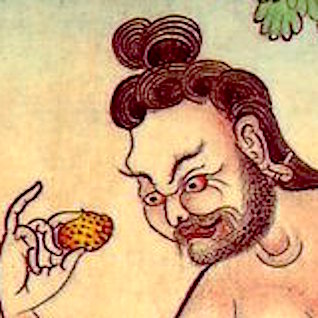
Lūipa ལཱུ་ཨི་པ། (“The Fish-Gut Eater” )
8th century CE
Mahasiddha #1
In the noble but uncommon tradition of the 1% voluntarily equalizing wealth, Luipa disdained his excessive riches and though born a king, like the Buddha he left his kingdom for a spiritual path. More than just his wealth though, Luipa’s teacher gave him a practice of abandoning his royal blood/Brahmin, food-purity culture prejudice by for 12 years eating only the fish guts normally intended only for dogs. This made him an untouchable and closed the door back to his former status and privilege. As a mendicant sage, he became an important teacher to many and passed into legend.
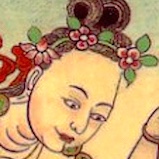
Manibhadra
10th C. CE
One of the 84 Mahasiddhas in the Tibetan Buddhist tradition and described as the “Happy Housewife’ siddha” and “Model Wife,” Manibhadra as a teenager met her teacher Kukkuripa and bravely followed him into the cremation grounds where she began practicing Vajrayana. Instead of leaving the conventional world to practice though, she married, had children and brought her spiritual practice into her daily life demonstrating the sacredness and enlightenment in the simple, ordinary world and becoming an exemplar to householders.
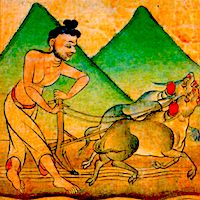
Medhini མེ་དྷི་ནཱི། (The Tired Farmer)
8th century CE
Mahasiddha #50
A low-born farmer working from early morning until late at night, Medhini decided to embark on a spiritual path but couldn’t get thoughts about farming out of his mind. His guru taught him how his thoughts about cultivating the earth could be understood, practiced, and applied to the cultivating of his own awareness. Having realized the non-duality of farming and realization, he discovered the unconditioned nature of reality and went on to teach and benefit countless students.
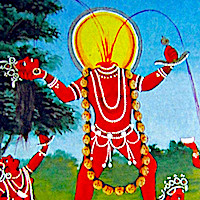
Mekhala མེ་ཁ་ལཱ། (“The Elder Severed-Headed Sister” )
late 9th century
Mahasiddha #66
One of two unmarried, mischievous daughters; Mekhal’s father married her off to an unsuspecting boy from another village. He soon realized though and an intense and constant “battle of the sexes” began. As their lives sunk into more and more misery, the younger sister—Kanakhala—suggested running away to another country. Mekhala, however, realized that their problems were self-created and would follow them wherever they travelled. This realization somehow seems to have triggered an encounter with a famous guru who initiated them onto a spiritual path. After 12 years, they returned to the guru but brought no offerings. According to the story, the guru asked for their heads and they immediately cut them off with “the keen-edged sword of pure awareness.”
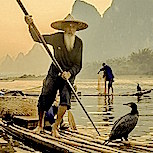
Minapa མཱི་ན་པ། (Macchaendra, Matsyendra, "The Hindu Jonah")
10th Century CE
Mahasiddha #8
Bengali fisherman, “India’s Jonah,” a hunter who became the hunted and swallowed by his prey; Minapa unexpectedly and unintentionally heard some highly secret dharma teachings, practiced alone for 12 years and then became a famous mahasiddha and teacher. Protector deity of Nepal, bringer of rain in drought, and original science of yoga teacher; Minapa is also revered in Nepal as the bringer of the first rice seeds. A symbol for the wisdom born in solitude and the journey into deep subconscious depths, he’s know for saying, “What a precious jewel is one’s own mind.”
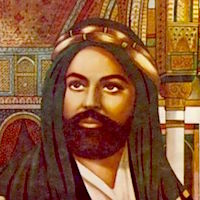
Muhammad محمد; محمد;
570 – 632 CE
Gfted political leader, sage lawmaker, just judge, sincere devotee of integrity; Muhammad was praised by Leibniz, Rousseau, Napoleon, and Thomas Carlyle but Voltaire thought of him as a symbol of fanaticism and called him "a sublime and hearty charlatan.” Although his integrity can be argued, his influence is indisputable. Founder and prophet of Islam, he launched a political and religious revolution that rapidly transformed a poverty-drenched Arabia from a desert of motley, contentious tribes into a force that within 100 years conquered half the Mediterranean world, Byzantine Asia, all of Persia and Egypt, and most of North Africa. A simple ascetic in most ways, he used eye shadow and perfume, dyed his hair, and kept an active harem. Building on the Zoroastrian, Jewish, and Christian traditions; he described elaborate visions of both heaven and hell that forged a unified, monotheistic tradition that unified the Arabs, spread throughout the world, and is still a potent influence today.
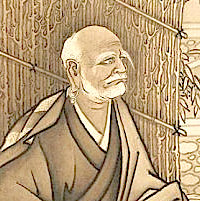
Nansen, Nanquan Puyuan 南泉普願
749 – 835 CE
Nansen, Nanquan Puyuan 南泉普願 Nánquán Pǔyuàn (749 – 835)
Tang Dynasty Chán master and inspiration for the “Golden Age of Chan;” Nansen, after 30 years meditating in a mountain retreat, came back to the world of people becoming a famous teacher and a key figure in many illuminating Zen anecdotes. Renowned for untangling the deep truth caught and hidden in the net of words, his direct communication and activity with students (including Joshu, Zhàozhōu Cōngshěn) directly provoked many enlightenment experiences. His koans appear in The Gateless Gate, The Blue Cliff Record, and The Book of Serenity.
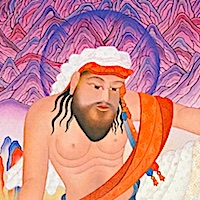
Nirgunapa ནིརྒུ་ཎ་པ།
(9th century)
"The Enlightened Moron" #57
Born into a low-caste family and inflicted with a moronic lassitude, depression, and such a lack of intelligence and skill that his parents thought it would have been better had he not been born; Nirgunapa sunk into the depths of suffering and despair. While unable to spark even enough motivation to beg for food, a teacher found him in a remote place and gave him enough food to survive. The teacher offered to give him a spiritual practice and Nirgunapa accepted with the condition that he not have to get up off his back. Exemplifying the principle of basic goodness in spite of possessing none of the materialistic qualities valued by society, he became a great teacher. While wandering through villages, when he met someone who asked him a question, he answered only by gazing into their eyes and crying which awoke in them a deep sense of compassion.
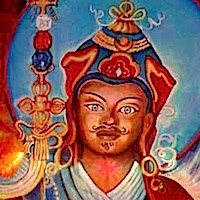
Padmasambhava པདྨཱ་ཀ་ར། ("The Lotus-Born", Guru Rinpoche)
8th century CE
Known as “The Second Buddha” and founder of Tibetan Buddhism the first Buddhist monastery in Tibet, and the Nyingma school; Padmasambhava came to Tibet at the request of King Trisong Detsen. Venerated also in northern India, Bhutan, and Nepal; Padmasambhava became famous for subduing “demonic forces” that prevented Buddhist teaching from becoming rooted in Tibet. Rather than conquering these negative influences, he took the tantric approach of transforming the demons into protectors. His name and symbolism comprise one of the most common and popular mantra-prayers in Tibetan Buddhism and is believed to communicate and inspire sacred teachings of transformation.

Prince Shotoku
574 – 622 CE
The son of emperor Yomei, Shotoku inspired a devotional tradition of protecting Japan, the Imperial Family, and Buddhism. His commentary on three famous Buddhist sutras in 615 CE are considered the first Japanese text. He also wrote the first Japanese constitution and is credited with creating a strong and united Japan. Still revered, his picture is on the Japanese 10,000 yen currency note.
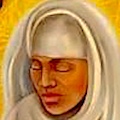
Rabia Basri رابعة العدوية القيسية (Rābi‘a al-‘Adawīyya)
714 – 801 CE
Muslim mystic, “queen of saintly women,” and most important early Sufi poet; Rabia Basri rose from the poverty and slavery of her youth to become the most famous and influential Sufi woman of Islamic history known as “the queen of saintly women.” She had many disciples and became an important influence on the leaders of her time as well as an early voice against spiritual materialism and Islamic patriarchy. She taught a doctrin of Divine Love known as Ishq-e-Haqeeqi that is still practiced today and emphasized spiritual practice without desire for reward or fear of punishment.
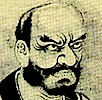
Rinzai Gigen 臨済義玄 (Línjì Yìxuán)
? - 866 CE
Student of Huangbo Xiyun, iconoclastic founder of a major Chán Buddhist school and one of the Five Houses of Zen, Rinzai; Gigen or Linji fiercely challenged students who accepted the superficial, conceptual meaning of buddhist teachings rather than penetrating the true meaning deeper than the words to find genuine wisdom and understanding. A book of his sayings recorded by one of his students, The Record of Rinzai (Zen Teachings of Rinzai), became one of the main texts for the Rinzai school as well as a big influence on buddhism and the evolution of consciousness in general. Known for his uncompromising approach to teaching that included yelling at and hitting his students, he directly continued the Buddha’s flower-sermon styleof non-conceptual teaching.
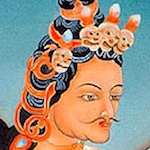
Saraha
8th century CE
Earliest Mahasiddha, founding father of the Buddhist Vajrayana and Mahamudra tradition; Saraha was expelled from a monastery for drinking alcohol, found a young low caste bride, became a maker of arrows, and went on to write the main Mahamudra meditation text and become a great yogi and master song writer. Like Lao Tzu, he followed the same “Inborn Natural Way” and began the lineage which descended through time to Tilopa, Naropa, Marpa, Milareapa and now to the Gyalwang Karmapa.
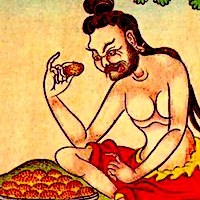
Sarvabhaksha སརྦ་བྷཀྵ། ( “The Glutton” )
late 8th, early 9th century
Mahasiddha #75
A born hungry, low caste man with an enormous appetite, Sarvabhaksha constantly dreamed about food, even after a huge feast. A chance meeting with the great siddha Saraha led to a vision of hungry ghosts—wretched wraiths with mouths like the eye of a needle and stomachs like an empty mountain—and a spiritual practice based on generosity and compassion. His insatiable desires shifted from food for himself to happiness for all sentient beings and he became a great teacher himself. His story demonstrates the the reality-changing power of visualization, both for the positive and the negative—on one hand the capacity of a Hitler to create a black magic hallucination creating the holocaust; on the other, positive visions like the American Dream, the Christian “Heaven on Earth”, and the Eastern Shambhala myths.
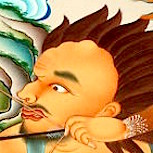
Śavaripa ཥ་ཝ་རི་པ། (Śabara, “The Hunter”)
8th – 9th C. CE
Mahasiddha #5
From the lowest wrung of untouchables and a wild, aboriginal tribe, the Śabaras; Shavaripa became a forefather of the Tibetan Kagyu lineage and a famous teacher. From a tradition known for crazed sexual passion, smoking marijuana, and drinking alcohol from a skull cup; he and his wife transformed their tradition into a potent symbol for tantric Buddhist practice. From a skilled and proud hunter, Shavaripa became a beacon of vegetarianism. Known as “Saraha the Younger” and a student of Nagarjuna, he transmuted aggression into loving kindness for all beings and through his disciple Maitipa transmitted this tradition to Marpa who brought it to Tibet.
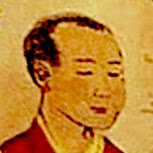
Shantideva ཞི་བ་ལྷ།།། (Bhusuku, Śāntideva)
685 – 763 CE
Son of a king, Indian scientist, Buddhist monk, "The Great Poet," and unliked Nalanda University scholar known for not studying, practicing meditation or showing up for events; Shantideva was challenged by the university to give a talk as proof that he really belonged there but really as way of getting rid of him. Shocking the scholars and monks who wanted to expel him, he gave a talk that became the famous Bodhicaryavatara, The Way of the Bodhisattva or Entering the Path of Enlightenment. Leaving the University and following Nagarjuna’s Madhyamaka philosophy, his teachings became a strong foundation for the Mahayana tradition. Mahasiddha #41
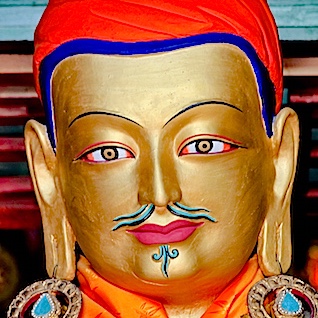
Songtsen Gampo སྲོང་བཙན་སྒམ་པོ
569 – 649 CE
Founder of the Tibetan nation, Songtsen Gampo unified Tibet, introduced Buddhism, many new cultural and technological improvements, created the Tibetan alphabet, the first constitution and model laws. After winning a war against China and influence over Nepal, he was given Nepalese and Chinese princess wives who helped him establish trade with surrounding countries and a golden age for Tibet. In Tibetan tradition, both wives are considered incarnations of Tara, the Goddess of Compassion, and Songtsen Gampo as a manifestation of the bodhisattva, Avalokiteśvara.
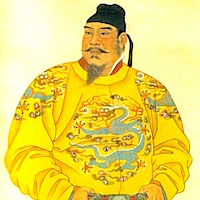
Taizong of Tang 唐太宗 唐太宗 (Li Shimin)
598 – 649 CE
One of China’s greatest emperors, co-founder of the Tang Dynasty which became the world’s most civilized power, and architect of a golden age—China’s most creative period; Taizong’s reign became the standard and measure for all future leaders. A scientific and Confucian scholar, he began by killing his brothers and expanding the empire but soon devoted himself to increasing peace and prosperity. Without personal dogma and prejudice, he welcomed Buddhist monks, Nestorian Christians, Zoroastrians, and made the capital so beautiful that it attracted hordes of tourists from as far away as India and Europe. He wrote a book reconciling Buddhism and Taoism, another one on government that became a popular reference for leaders in many different countries, promoted the arts, and it was said of people during that time, “whoever was a man, was poet.” Over 1000 years later, a Manchu emperor commissioned an anthology of Tang poems that included 48,900 poems by 2,300 poets.
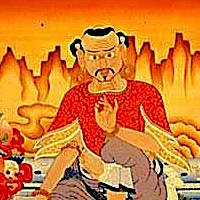
Tantepa
8th century CE
Tantepa ཏངྟེ་པ། “The Compulsive Gambler (8th century CE) #33
A stereotypical gambler who lost all his money, lost all his credit, lost all his friends, lost all his self-respect but still couldn’t stop gambling even with the wise teacher he met who offered to show him a path away from his intense suffering; Tantepa was intrigued when this teacher agreed to show him a spiritual path based on his gambling experience instead of only moralizing and telling him to change. Instead of fighting against his strong feelings, his practice became looking directly into the experience of emptiness he had when losing, extending that perception to the worlds of sense, form and his own mind. This led to his realization that all thoughts and beliefs are equally empty and a new life as a teacher famous for his compassion and insight into the human failings of his students.
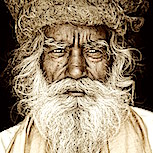
Tantipa ཏནྟི་པ། ("The Senile Weaver")
1st half of 9th century
Mahasiddha #13
When he was 89 years old, Tantipa’s wife died and he became increasingly decrepit and senile. Becoming more and more of a liability to his weaving business and an embarrassment to his family, they built a hidden-away hut for him so they and visitors wouldn’t have to see or hear him. A passing-through Mahasiddhia, Jalandhara gave him teachings and practices to prepare for death and after many years of his silent meditation practice, he overcame the debilities of old age, attained the highest realization, became involved again in his cultural world even stopping the practice of animal sacrifice in his district. His life symbolizes and represents both the internal and external potentials of old age, the inspiration that any condition is fertile ground for enlightenment.
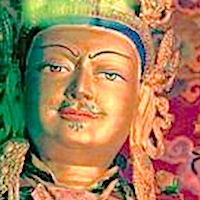
Trisong Detsän ཁྲི་སྲོང་ལྡེ་བཙན།
806 – 838 CE
Trisong Detsun, Ralpacan, Tritsuk Detsen, ཁྲི་གཙུག་ལྡེ་བཙན (806 - 838 CE)
One of the famous three “Dharma Kings” who brought Buddhism to Tibet and extended the Tibetan empire to its largest size encompassing parts of modern-day India, Nepal, Khotan, and a large territory in modern China including Sichuan, Xinjiang, and Gansu provinces; Trisong Detsun negotiated a peace treaty with the Uyguhurs in the north and with the Chinese in the east. He brought to Tibet hundreds of scholars, craftspeople, and translators who developed Tibetan literature, a Sanskrit-Tibetan dictionary, and translations of the Tripitaka, Buddhist commentaries, and ancient Tantras. He introduced weight and measurement systems from China, monastic religious organization from India, and set up a system of patronage for priests assigning support from 7 families for each Buddhist monk.
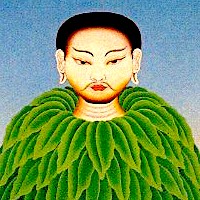
Udhilipa ཨུ་དྷི་ལི་པ།
(9th century CE)
The Bird-Man
On an external level, Udhilipa’s story seems very common: an aristocrat with a great fortune meeting a guru, practicing for many years, and finally achieving realization and psychic powers, in this case an ability to fly. Understanding his story in symbolic terms; however, points toward esoteric inner yoga practices including methods of waking up the 8 body mandala centers that divide into 24 cakras and then into a thousand capillary channels. And as we’ve seen in numerous yogic stories of liberation, flying can mean the freedom from conceptual prisons, body identification, and ego-centric illusions.
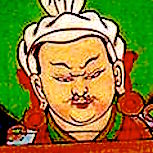
Vinapa
8th century CE
Only son of a King, so obsessed with music he would barely stop for food, Vinapa refused to learn about politics and leadership, would only listen to and play music. In a desperate attempt to win his attention, his parents found the great yogin Buddhapa to teach him. His attention was won but the master gave him a music meditation practice saying, “Free yourself of all duality between the sound itself and what your mind perceives. Without concept or judgement, contemplate only pure sound.” Vinapa became enlightened and a great Mahasiddha teaching and benefiting countless beings.
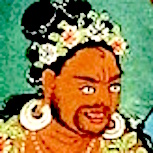
Virupa བི་རཱུ་པ། (“Dakini Master”)
9th century CE
Mahasiddha #3
Though the hero of many miraculous stories of walking on water, making the sun in the sky stop moving, subjugating demons and over-coming Hindu gods; the main symbolism of Virupa’s life revolved around understanding the sense and not just the words, of following a path of moment-to-moment awareness rather than an external set of values, ethics, and discipline. Revered in the Sakya lineage of Tibetan Buddhism as the first lama in the “Journey without Goal School,” he was kicked out of a monastery after living and practicing there for more than 25 because of eating meat and drinking alcohol. The monks soon recognized their mistake and begged him to return but he refused and continued his aimless wondering exemplifying Lao Tzu’s description of wu wei.
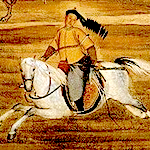
Wang Zhen
809 – 859 CE
Wang Zhen (FL. 809)
Tang Dynasty general in the tradition of Ashoka, Wang Zhen saw his military prowess and success from the higher perspective of how much unnecessary suffering it caused the population. Sickened by the consequences of his victories, he turned to the Tao Te Ching for answers and alternatives to conflict and war. This led to deep realizations, practical solutions for avoiding violence, and his commentary on Lao Tzu called The Tao of War that extended Wang Zhen’s insights on political and military struggle into the personal, competitive realms of daily life. His pacifist sympathies had greater impact because of his martial respect.

Wu Zetian
624 – 705 CE
In more than 4000 years of Chinese history, Wu was the only female emperor (not just consort or dowager). Historians accused her of violent acts - murder, torture and corruption; but this may be history being re-written by the victors, later Confucian successful attempts to discredit her and the feminine equality she promoted. She made the Tao Te Ching required reading for imperial university students and continued the Tang tradition of claiming Laozi as a clan ancestor. She supported self-sufficient farmers and ensured fair land allocations. Three of her sons also became emperors and one of her grandsons became the renowned Emperor Xuanzong of Tang.
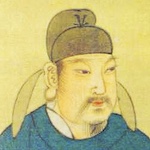
Xuanzong 武隆基 (Hsuan-Tsung or Wu Longji)
685 – 756 CE
Tang emperor famous for many things including his poetry and calligraphy as well as establishing one of China’s golden ages. He was deeply interested and influenced by both the Taoist and Buddhist traditions and his long reign of 43 years was a period of peace, political stability, and economic prosperity with many advances in education, music, painting, sculpture, and literature. He wrote a commentary on the Tao Te Ching, Yu-chu tao-te-chen-ching and had others commissioned.
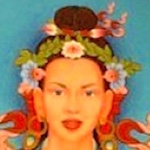
Yeshe Tsogyal ཡེ་ཤེས་མཚོ་རྒྱལ (Sky Dancer)
777 – 837 CE
Believed to be the reincarnation of the Buddha's own mother, Yeshe Tsogyal is the most famous of the enlightened women of Tibet and considered a female Buddha manifesting in the world in a way to teach an enlightened path in everyday life. She appeared as ordinary girl, princess, prostitute, business woman, and enlightened guru. Given from the king, Trisong Detsen’s harem to Padmasambhava who freed her, she helped establish Buddhism in Tibet and concealed terma for future generations.
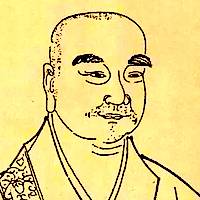
Yòngjiā Xuānjué 永嘉玄覺 (Yung-chia Ta-shih; Yōka Genkaku; "The Overnight Guest")
665 – 713 CE
Called “the Overnight Guest" because of proving his realization to Huineng in just one night, Yongjia is best remembered because of his writings, especially the Song of Enlightenment or Song of Freedom (Shodoka 證道歌) still popular in contemporary Western Zen circles and memorized by students in Asia. It emphasizes practice over study and the contrast between dharma nature and buddha nature. Yongjia is famous for not having a teacher but realizing enlightenment from only reading and contemplating the Sutras.
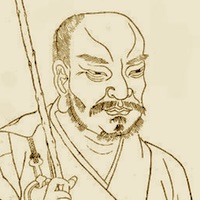
Yunmen Wenyan 雲門文偃 (Ummon Daishi, Yúnmén Wényǎn)
862 – 949 CE
The most eloquent Chan master
One of the most famous Zen masters in later day Japan, Ummon founded one of the five major Chán schools in China. This school compiled and wrote the Blue Cliff Record, flourished for hundreds of years, and continues today. Supported by the region's king, and famous throughout China and Korea, Ummon rejected the fame and many offered honors while building a new monastery in a more remote location. Many of his recorded statements later became koans—5 listed in The Gateless Gate, 8 in the Book of Equanimity, and 18 in the Blue Cliff Record.

Zainab, Sayyeda Zaynab bint Ali زينب بنت علي
626 – 681 CE
Grand-daughter of the Prophet Muhammad, daughter of revered leader Ali ibn Abi Talib (regarded by Shia as the most important figure after Muhammad, by Sunnis as the greatest warrior champion of Islam, and by Sufis as the originator of their lineage; his legacy split Islam into Shia and Sunni), effective political leader, and one of the most admirable people in early Islam; Zainab - famous for her wisdom, strength and patience - is a rare instance of reverence for both Sunnis and Shi’as. Called the "Hero of Karbala,” she endured physical pain and mental torture to stand up against tyranny, speak the truth, and set Islam on a more just and compassionate course. In Iran today her birthday is known as Nurse's Day.

Ziryab أبو الحسن علي ابن نافع, زریاب (Abu l-Hasan, “Blackbird”)
789 – 857 CE
Singer, poet, polymath, freed slave, teacher, and one of the greatest influences on world culture; Ziryab’s name is almost unknown in most of the world although the traditions and styles he initiated are commonplace. He invented and popularized the early form of toothpaste, the three-course meal, asparagus, the use of tablecloths, wearing hair in bangs, and using glass containers for drinks. Founder of the 500-year Andalusian music tradition, he laid the early groundwork for classic Spanish music, revolutionized the musical instrument design that became the lute, and created a musical style that influenced European minstrels, troubadours, and the course of European music.
Chinese Eras
Xia Dynasty 夏 (2100 – 1600 BCE)
Shang Dynasty 殷代 (1600 – 1046 BCE)
Western Zhou 西周 (1046 – 771 BCE)
Eastern Zhou 東周 (770 – 256 BCE)
Spring and Autumn period 春秋时代 (770 – 476 BCE)
Warring States period 春秋时代 (476 – 221 BCE)
Qin Dynasty 秦朝 (221 – 206 BCE)
Three Kingdoms 三國時代 (220 – 280 CE)
Southern and Northern 南北朝 (420 – 589 CE)
Tang Dynasty 唐朝 (618 – 907 CE)
5 Dynasties 10 Kingdoms (907 – 960 CE)
5 Kingdom of Dali 大理国 (937 – 1253 CE)
Western Xia 西夏 (1038 – 1227 CE)
Southern Song (1127 – 1279 CE)
Comments (0)